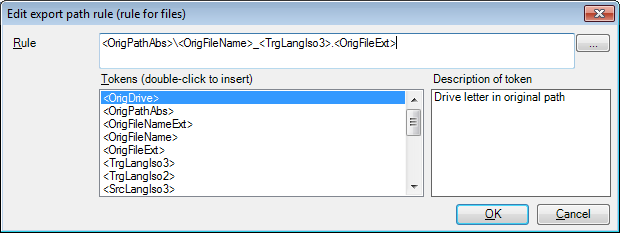|
The Edit export path rules dialog allows you to make changes to the selected set of export path rules. You can also edit remote export path rules if you have sufficient privileges, however, one set may only be edited by one person at a time. How to beginYou can invoke the Edit export path rules dialog from the Export path rules category of the Settings pane in Project home or the Export path rules pane of the Resource console, by selecting the set you wish to edit, and clicking the Edit command. StructureThe Edit export path rules dialog consists of the Rule section for switching between file or folder rules, the Tokens section and the Description of token section. •Rule: You can write the path using backslashes with fixed strings and/or with tokens. You can also use the
<BasePathAbs>_<TrgLangIso3>\<RelativePath>\<OrigFileNameExt> This means that during the export, the documents are saved into the very same folder they came from and with names consisting of the three-letter target language code, the path within the base folder, and the original file name. •Tokens (double-click to insert): Use this pane to insert a token from the list after the current cursor position in the Export path rule field. •Description: This field indicates the description of the token selected in the Tokens pane.
Tokens you can use: <InputRoot>: Inserts the folder path that leads to the topmost folder in the folder structure you are watching (this is for content connected projects only). <RelativePath>: Inserts the relative path of the exported file within the root folder. <OrigFileNameExt>: The name and extension of the original source file. <OrigFileName>: The name of the original source file, without the extension. <OrigFileExt>: The extension of the original source file. <ExportDateTime>: The date and time of exporting the translated file. <ExportDate>: The date of exporting the translated file. <ExportTime>: The time of day of exporting the translated file. <TrgLangIso3>: The 3-letter ISO code of the target language. <TrgLangIso2>: The two-letter ISO code of the target language. <SrcLangIso3>: The 3-letter ISO code of the source language. <SrcLangIso2>: The two-letter ISO code of the source language. You can also include <Client>, <Project>, <Domain>, <Subject> in the export path. NavigationClick OK to close the Edit export path rules dialog, saving all changes. Click Cancel to close the dialog without saving changes.
See also: •Set the output folder and file name for exporting documents |
